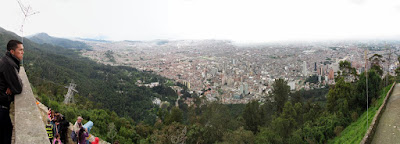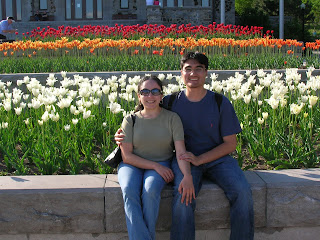
Parque Nacional Tayrona
We spent a day visiting Tayrona National Park, a park that has many gorgeous beaches with mountains and lush green jungle in the background. The park’s main entrance is located about a 45 minute drive east of Santa Marta. From the main entrance we took a colectivo (small van) to the first beach called Cañaveral. From there we had the option of either walking (one hour) or riding a horse (45 minutes) to reach the next beach, Arrecifes. We opted for the horses because it had rained the night before and were told that the path would be very muddy. I’m really thankful we did, otherwise we would have been ankle deep in mud in some areas of the path!
Arrecifes is one of the most beautiful beaches in the park, and the jungle comes right up to the coastline. However, the beach is not safe for swimming, and a sign at the entrance to the beach warns that over 200 people have drowned at Arrecifes.

Fortunately, there is a nice beach called La Piscina that is safe for swimming, located about a 40 minute hike from Arrecifes. The water at La Piscina was warm and the sand was very soft.

More Photos of Parque Tayrona
Taganga and Playa Grande
Taganga is a small fishing village set in a little bay about a 15 minute drive from Santa Marta. Taganga is a fun, relaxed beach town full of backpackers with lots of little restaurants and kiosks along the beach serving delicious fresh fish and natural fruit juices.
Taganga is a small fishing village set in a little bay about a 15 minute drive from Santa Marta. Taganga is a fun, relaxed beach town full of backpackers with lots of little restaurants and kiosks along the beach serving delicious fresh fish and natural fruit juices.
On the way to Taganga our cab driver offered to stop at the Taganga mirador (lookout point) so that we could get a nice view of the town. The view was spectacular!

In Taganga we enjoyed walking along Carrera 1, the street parallel to the beach, and had some delicious robalo (snook fish) at a restaurant called Bitacora. After lunch we walked to the eastern end of the town where there is a path over a hill leading to the Playa Grande. Minh got some great photos of Playa Grande from the top of the hill. The walk to Playa Grande took us about 30 minutes. We then spent the rest of the afternoon relaxing at Playa Grande and enjoying the ocean.

More Photos of Taganga
La Quinta de San Pedro Alejandrino
La Quinta is a 17th century hacienda (plantation) where Simon Bolivar spent his last days before dying of tuberculosis. The room where he passed away is on display, and many of the hacienda’s furnishings from the time of his death have been well preserved. La Quinta is also surrounded by nice gardens. We spent an afternoon exploring the Quinta and learning a bit about Bolivar’s final days.
La Quinta is a 17th century hacienda (plantation) where Simon Bolivar spent his last days before dying of tuberculosis. The room where he passed away is on display, and many of the hacienda’s furnishings from the time of his death have been well preserved. La Quinta is also surrounded by nice gardens. We spent an afternoon exploring the Quinta and learning a bit about Bolivar’s final days.

More Photos of Quinta De San Pedro Alejandrino
Where to stay in Santa Marta
Minh and I were not particularly impressed with the city of Santa Marta. We both found it to be rather dirty and a bit seedy. We were glad that we decided to stay in El Rodadero, a beach town located a 10 minute drive south of Santa Marta. El Rodadero is very clean, very safe, and full of Colombians on vacation. I didn’t see any other gringos there during our 4 nights in El Rodadero. We really liked our hotel, Hotel Betoma. The room was spacious, very clean, had a nice balcony, air-conditioning and hot water in the shower. And it was a bargain at $50 USD per night.
Minh and I were not particularly impressed with the city of Santa Marta. We both found it to be rather dirty and a bit seedy. We were glad that we decided to stay in El Rodadero, a beach town located a 10 minute drive south of Santa Marta. El Rodadero is very clean, very safe, and full of Colombians on vacation. I didn’t see any other gringos there during our 4 nights in El Rodadero. We really liked our hotel, Hotel Betoma. The room was spacious, very clean, had a nice balcony, air-conditioning and hot water in the shower. And it was a bargain at $50 USD per night.
El Rodadero had some nice restaurants. We really enjoyed eating fresh fish at Pez Caribe, and were pleasantly surprised at the quality of the pizza at Pizzetta. We also found a cool little bar that played Latin, American and British rock. I can’t remember the name, but it’s located on the corner of Carrera 4 and Calle 9, across the street from Pizzetta. We drank Mojitos while listening to the Beatles, the Rolling Stones, Soundgarden and Metallica. The highlight for us was when the DJ played Don McLean’s American Pie. Yes, we are gringos.
Taganga also seemed to us like a fun and safe place to stay. Taganga has a lot of hostels with very low prices.



















